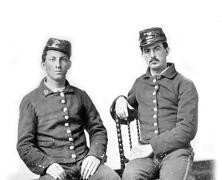
Passionate Abolitionist and
Witness to the American Civil War


Passionate Abolitionist and
Witness to the American Civil War

Thomas Jackson’s opinions and accounts of the war are totally one sided and, as such, may be seen as shameful northern propaganda to some. He was always passionate in his support for the abolition of slavery and he had little good to say for folk who supported the confederacy for he considered that claims for State’s Rights were simply an excuse for the continuation of slavery. So this may make his writings hard to read for those who, with the wisdom of hindsight, might feel that the war was fought by good men on both sides who were doing what they felt was right by the standards of their upbringing and honor in those times.
Some will view Thomas Jackson badly as an extremist fire brand who would never seek peace through compromise or recognize that many fighting for the South did not own slaves but were supporting their family and neighbors who objected to the Federal Government forcing them to stay in the union
Others will view him well as a clear headed opinion leader who actively and unwaveringly supported the “right” side of abolition cause from its early days.
Both are right.
But we should also remember that enormous casualties were suffered by people of both sides. In total over 620,000 American soldiers from the north and south died in the civil war. This represented 2% of the whole population at the time. While many died from combat, accident and starvation, many more died from disease and medical problems. In addition about 3 million were injured. This was the most terrible catastrophe for thousands of well meaning Americans on both sides.
With that awareness, we would like to think that presenting these personal, on-the-spot accounts of one individual’s feelings and decisions about war might illuminate not just what took place in the past but also similar issues that might come about under different circumstances in the present day. The scale of the devastation on all sides should persuade us to think again about the possible escalation that can result from going to war and unleashing the infectious poison of vengeance.

General Stonewall Jackson standing on a ridge with soldiers, one holding Jackson’s horse, monitoring the action of the battle at Bull Run, Aug. 17, 1861
This is the OTHER Thomas Jackson who was a significant leader of the confederate forces but was never mentioned by name by the author of these letters
The First Battle of Bull Run, also known as First Manassas (the name used by Confederate forces), was fought on July 21, 1861, in Prince William County, Virginia, near the city of Manassas. It was the first major land battle of the American Civil War. Just months after the start of the war at Fort Sumter, the Northern public clamored for a march against the Confederate capital of Richmond, Virginia, which they expected to bring an early end to the rebellion. Yielding to political pressure, Brig. Gen. Irvin McDowell led his unseasoned Union Army across Bull Run against the equally inexperienced Confederate Army of Brig. Gen. P. G. T. Beauregard camped near Manassas Junction. McDowell’s ambitious plan for a surprise flank attack on the Confederate left was poorly executed by his officers and men; nevertheless, the Confederates, who had been planning to attack the Union left flank, found themselves at an initial disadvantage.
Confederate reinforcements under Brig. Gen. Joseph E. Johnston arrived from the Shenandoah Valley by railroad and the course of the battle quickly changed. A brigade of Virginians under a relatively unknown colonel from the Virginia Military Institute, Thomas J. Jackson, stood their ground and Jackson received his famous nickname, “Stonewall Jackson”. The Confederates launched a strong counterattack, and as the Union troops began withdrawing under fire, many panicked and the retreat turned into a rout. McDowell’s men frantically ran without order in the direction of Washington, D.C. Both armies were sobered by the fierce fighting and many casualties, and realized the war was going to be much longer and bloodier than either had anticipated.
Source Library of Congress. See http://www.loc.gov/pictures/item/201.3645264/

Two young confederate soldiers out of the thousands on both sides dragged in to war by the convulsions overwhelming their country

Confederate dead at Antietam. Casualties for both the Union and Confederates were approximately 23,500. September, 1862.

Gettysburg, Pa. Bodies of Federal soldiers, killed on July 1, near the McPherson woods
1.State Archives of Florida, Florida Memory, http://floridamemory.com/items/show/34054 Image # RCI11558